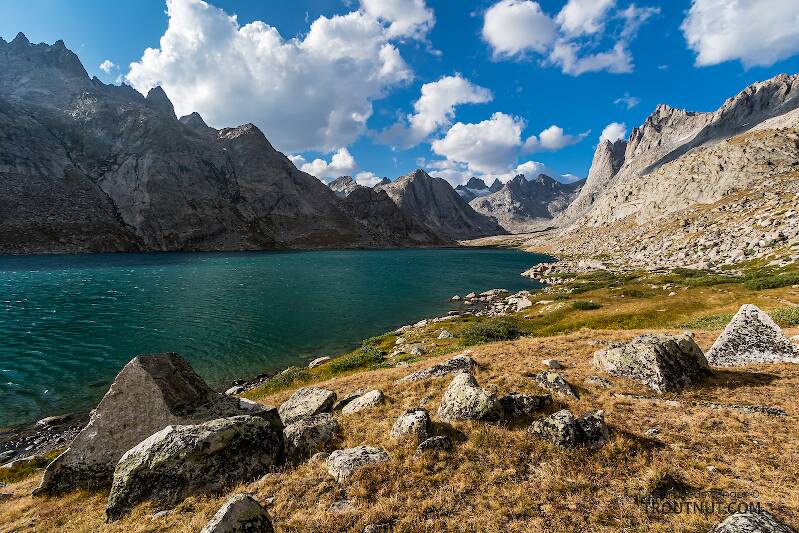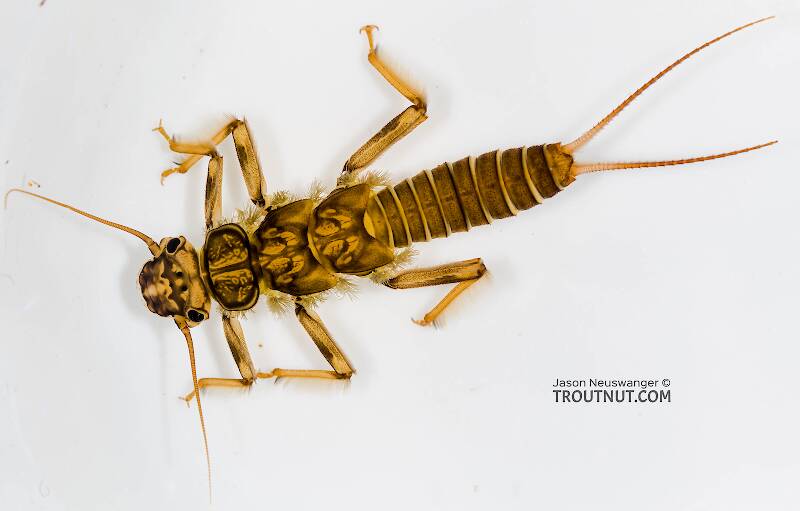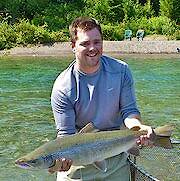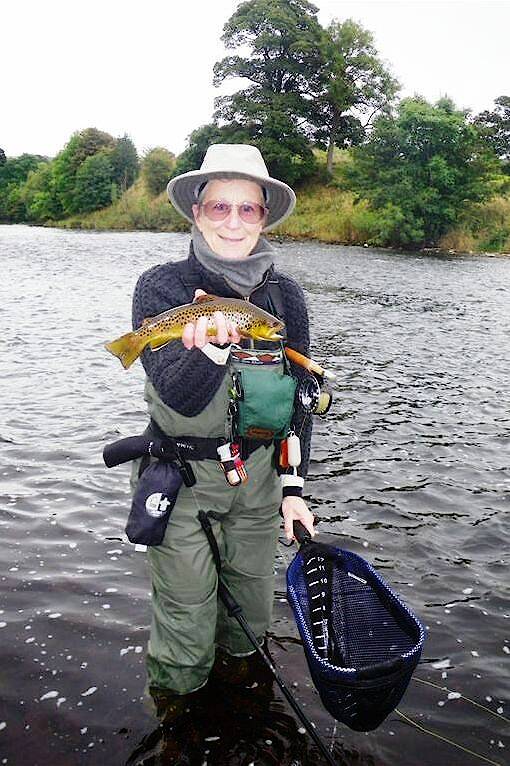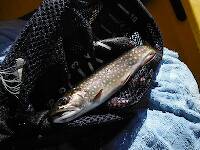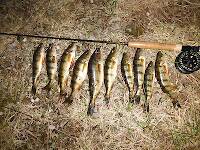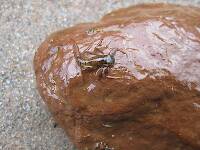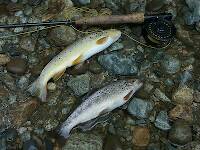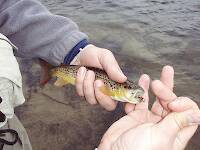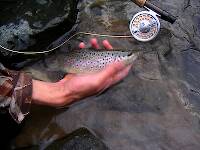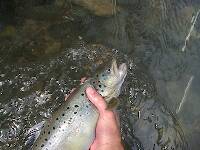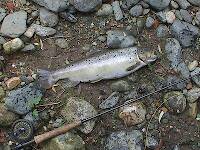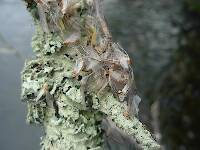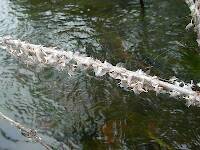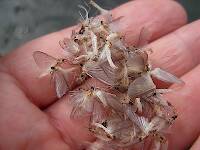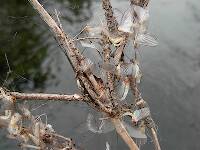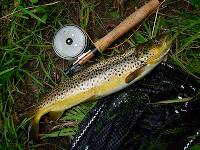
Salmonflies
Pteronarcys californica
The giant Salmonflies of the Western mountains are legendary for their proclivity to elicit consistent dry-fly action and ferocious strikes.
Featured on the forum

Troutnut is a project started in 2003 by salmonid ecologist Jason "Troutnut" Neuswanger to help anglers and
fly tyers unabashedly embrace the entomological side of the sport. Learn more about Troutnut or
support the project for an enhanced experience here.
Willy on May 29, 2007May 29th, 2007, 2:35 pm EDT
My Dad and I were just Striper fishing on Long Island Sound at the mouth of our harbor (didn't catch anything). The harbor is fed by a small river. It's probably tidal for a mile or two from where we were at the mouth of the harbor, so it's significantly salt/brackish water in the general location that we were fishing. Any tributaries in the area are the same way - big tidal influence, so I don't think there is any freshwater near where we were.
As I was fishing, I saw some mayfly spinners, probably a dozen of them doing their dance. They weren't linked up, but had very clear wings and were almost certainly spinners. They had yellow bodies with some brown markings on the top side of the body. I couldn't get one for a picture unfortunately. Moreover, there was no wind at all, and it's been pretty calm the past few days, so it's not like they blew down from far away, nor was there a significant light source that would have attracted them.
So any thoughts on what they were, or why they were so far from freshwater?
As I was fishing, I saw some mayfly spinners, probably a dozen of them doing their dance. They weren't linked up, but had very clear wings and were almost certainly spinners. They had yellow bodies with some brown markings on the top side of the body. I couldn't get one for a picture unfortunately. Moreover, there was no wind at all, and it's been pretty calm the past few days, so it's not like they blew down from far away, nor was there a significant light source that would have attracted them.
So any thoughts on what they were, or why they were so far from freshwater?
Check out my fishing pictures on Instagram.
CaseyP on May 29, 2007May 29th, 2007, 3:03 pm EDT
Hey Willy! we saw a few mayflies at the beginning of their season when the shad were running in the tidal Potomac, at Washington, D. C. in late April. i was sure some emerged right in front of us: nice yellowy tan ones with two tails, not very big, maybe 16s. and that water is not quite fresh. probably not as salty as your harbor, though.
"You can observe a lot by watching." Yogi Berra
Taxon on May 29, 2007May 29th, 2007, 3:05 pm EDT
According to W. Patrick McCafferty on page 95 of his wonderful book, Aquatic Entomology, in the paragraph describing aquatic habitats of mayflies, he says, "Although highly atypical of mayflies generally, at least one species has occasionally been found in tide pools, ..."
He doesn't go on to say which species this is, but perhaps someone reading this will. Et tu, Konchu!
He doesn't go on to say which species this is, but perhaps someone reading this will. Et tu, Konchu!
Konchu on May 29, 2007May 29th, 2007, 4:25 pm EDT
Not sure if any actually "prefer" to live in brackish water, but certainly some wash down into it, and a few survive, at least for a little while. Spinners would dance over still saltwater just as likely as freshwater or a shiny car. I may try to investigate further, however...
I'll keep you posted.
I'll keep you posted.
Konchu on May 30, 2007May 30th, 2007, 5:15 am EDT
According to The Source, the answer is that some Callibaetis species are occasionally found in tide pools.
However, based on my field experience, I am skeptical about whether these species actually live there as larvae or just were found surviving there, having been washed in from elsewhere.
At any rate, imitations of the spinners probably could be effective on the right day(s). Anyone with experience care to speak up?
However, based on my field experience, I am skeptical about whether these species actually live there as larvae or just were found surviving there, having been washed in from elsewhere.
At any rate, imitations of the spinners probably could be effective on the right day(s). Anyone with experience care to speak up?
Taxon on May 30, 2007May 30th, 2007, 9:15 am EDT
Thanks for the finding out, Konchu.
Willy on Jun 1, 2007June 1st, 2007, 2:33 am EDT
Good info! I'm not sure the stripers would be too interested in the mayflies, when foot long bunker or 3 inch long sand eels are prevalent, but you never know. Thanks for giving a little insight into the mystery, I'll let you know if I can make any other observations about the bugs.
Check out my fishing pictures on Instagram.
Konchu on Jun 1, 2007June 1st, 2007, 4:29 pm EDT
Summarizing/Paraphrasing from The Mayflies of Florida (1988 ed., pg. 127): Three species known from North America have been reported from saline/brackish waters: Callibaetis floridanus (Baetidae), Choroterpes mexicanus (Leptophlebiidae), Cloeon dipterum (Baetidae). Northern African species from the genera Cloeon and Caenis (Caenidae) have been found in these waters, so Caenis is a possibility here. A species from the genus Palingenia (Palingeniidae) may have been found in brackish waters.
I am aware of one ephemerellid species that has been collected from western brackish waters.
If anyone can grab some specimens from salt water, please let me know! For the time being, I'm going to stand by my assumption that mayflies' occurence in brackish waters is incidental.
I am aware of one ephemerellid species that has been collected from western brackish waters.
If anyone can grab some specimens from salt water, please let me know! For the time being, I'm going to stand by my assumption that mayflies' occurence in brackish waters is incidental.
Quick Reply
Related Discussions
Topic
Replies
Last Reply
14
May 5, 2016
by Martinlf
by Martinlf
5
Aug 7, 2007
by Wiflyfisher
by Wiflyfisher

